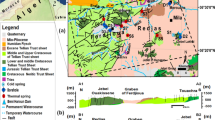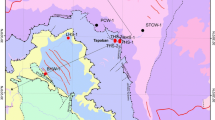Abstract
Given the vital importance of water and energy in desert regions, we undertook a study dealing with the deep reservoirs in Gabes area, which is located in the southeastern part of Tunisia. Geothermal resources are taken from the Intercalary Continental [or Continental Intercalaire (CI)], known as the largest deep aquifer in Tunisia and are used in a number of applications, mainly in agriculture. Previous investigations performed on the thermal waters of this area focused on the genesis of the deep waters with regard to the thermal features of geothermal reservoirs. A more detailed investigation has been carried out, considering both deep and shallow waters. In order to estimate the potential temperatures of deep reservoir in the Gabes area, we developed a synthetic study including chemical geothermometers, multiple mineral equilibrium approach, and other approaches. Chemical types of the thermal waters and effects of mixing between shallow cold waters with deep thermal waters were also discussed. In fact, the application of Na–K–Mg diagram relative to deep geothermal reservoir capitulate estimated temperatures (about 90°C). In addition, the multiple mineral equilibrium approach submits a similar estimated temperature ranging between 65 and 70°C, showing a disequilibrium status which indicates a possibly mixing with surface water. Indeed, wells exploiting the CI aquifer in the south part of the studied area showed the same characteristics, corroborating the reliability of the applied methods.








Similar content being viewed by others
References
Arnórsson S, (1975) Application of the silica geothermometer in low-temperature hydrothermal areas in Iceland. American Journal of Science 275:763–784
Ben Baccar B (1982) Contribution à l’étude hydrogéologique de l’aquifère multicouche de Gabés-Sud, Thése de 3ème cycle. Univ. Paris-Sud (Centre d’Orsay), pp 116
Ben Dhia H (1987) Geothermal energy in Tunisia: potential of the southern province. Geothermics 16:299–318
Bouaziz S, Barrier E, Souissi M, Turki MM, Zouari H (2002) Tectonic evolution of the northern African margin in Tunisia from paleostress data and sedimentary record. Tectonophysics 357:227–253
Bouri S, Makni J, Ben Dhia H (2008) A synthetic approach integrating surface and subsurface data for prospecting deep aquifers: the Southeast Tunisia. Environ Geol 54:1473–1484
Calmbach L (1995) Géochimie et composition isotopique des eaux thermominérales du fosse rhénan inférieur. Sciences de la Terre, Ph.D. thesis Uni-L. Durov SA (1948) Natural waters and graphic representation of their compositions. Dokl Akad Nauk SSSR 59:87–90
Choi H-S, Koh Y-K, Bae D-S, Park S-S, Hutcheon I, Yun S-T (2005) Estimation of deep reservoir temperature of CO2-rich springs in Kangwon district, South Korea. J Volcanol Geotherm Res 141:77–89
D’Amore F, Scandiffiot G, Panichi C (1983) Some observations on the chemical classification of ground wathers. Geothermics 12:141–148
D’Amore F, and Mejia JT (1999) Chemical and physical reservoir parameters at initial conditions in Berlingeothermal field, El Salvador. A first assessment. Geothermics 28:45–74
Fournier RO (1981). Application of water geochemistry to geothermal exploration and reservoir engineering. In: Rybach L, Muffler LJP (eds) Geothermal systems: Principles and case histories. Wiley, NY, pp 109–143
Giggenbach WF (1988) Geothermal solute equilibria. Derivation of Na-K- Mg- Ca geoindicators. Geochim Cosmochim Acta 52:2749–2765
Giggenbach WF, Sheppard DS, Robinson BW, Stewart MK, Lyon GM (1994) Geochemical structure and position of the Waiotapu geothermal field, New Zealand. Geothermics 23:599–644
Lloyd JW, Heathcote IA (1985) Natural Inorganic Hydrochemistry in Relation to Groundwater. Clarendon Press, Oxford
Makni J (2006) Eude du potentiel en eau thermale de la région de Zarat (Gabes Sud). Masters Faculty of Science. Sfax, Sfax University, p 103
Mamou A (1990) Charactérisation et évaluation des ressources en eau du Sud tunisien. Thèse de doctorat d’état es sciences naturelles. Univ. Paris-Sud, centre d’Orsay, pp 426
Mhamdi A (2003) Contribution de la géophysique à l’étude des relais hydrogéologiques des nappes de Gabès sud, mémoire de DEA, p 92
Pang ZH, Reed M (1998) Theoretical chemical thermometry on geothermal waters: problems and methods. Geochim Cosmochim Acta 62:1083–1091
Park S-S, Yun S-T, Chae G-T, Hutcheon I, Koh Y-K, So C-S, Choi H-S (2006) Temperature evaluation of the Bugok geothermal system, South Korea. Geothermics 35:448–469
Reed M and Spycher N (1984) Calculation of pH and mineral equilibria in hydrothermal waters with application to geothermometry and studies of boiling and dilution. Geochim cosmochim Acta 48:1479–1492
Simler R (2007) D I A G R A M M E S: logiciel d’hydrochimie multilangage en distribution libre, version 4. Laboratoire d’Hydrogéologie d’Avignon
Taran Y, Rouwet D, Inguaggiato S, Aiuppa A (2008) Major and trace element geochemistry of neutral and acidic thermal springs at El Chichón volcano, Mexico: implications for monitoring of the volcanic activity. J Volcanol Geotherm Res 178:224–236
Trabelsi R (2005) Salinisation des nappes côtières: cas de la nappe nord du Sahel de Sfax, Tunisie. CR Geosci 337:515–524
Acknowledgments
The authors warmly thank the anonymous reviewers for their detailed and constructive criticisms, which were of great help in improving this manuscript.
Author information
Authors and Affiliations
Corresponding author
Rights and permissions
About this article
Cite this article
Makni, J., Bouri, S. & Ben Dhia, H. Hydrochemistry and geothermometry of thermal groundwater of southeastern Tunisia (Gabes region). Arab J Geosci 6, 2673–2683 (2013). https://doi.org/10.1007/s12517-011-0510-5
Received:
Accepted:
Published:
Issue Date:
DOI: https://doi.org/10.1007/s12517-011-0510-5




